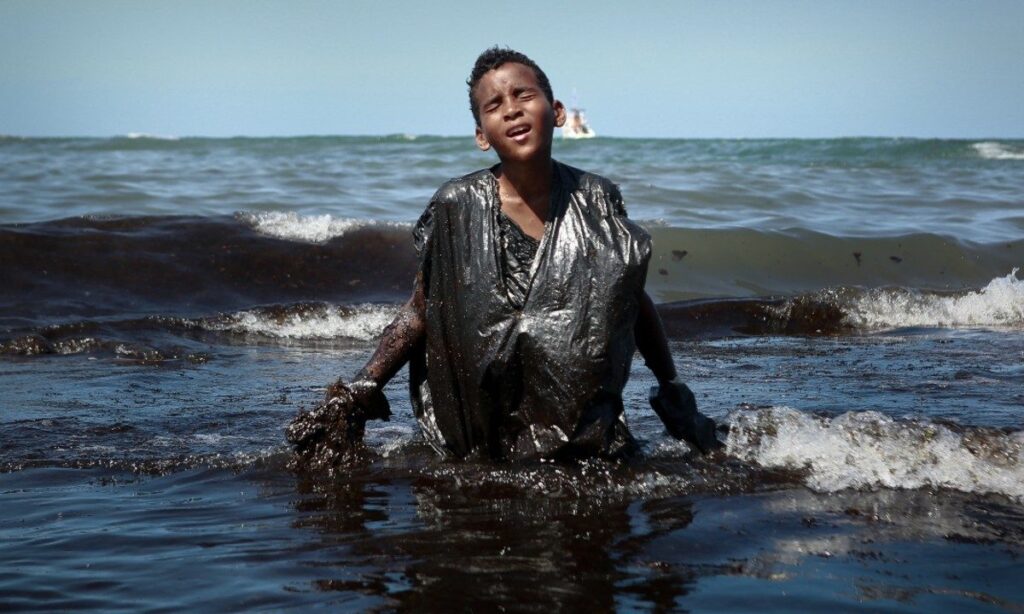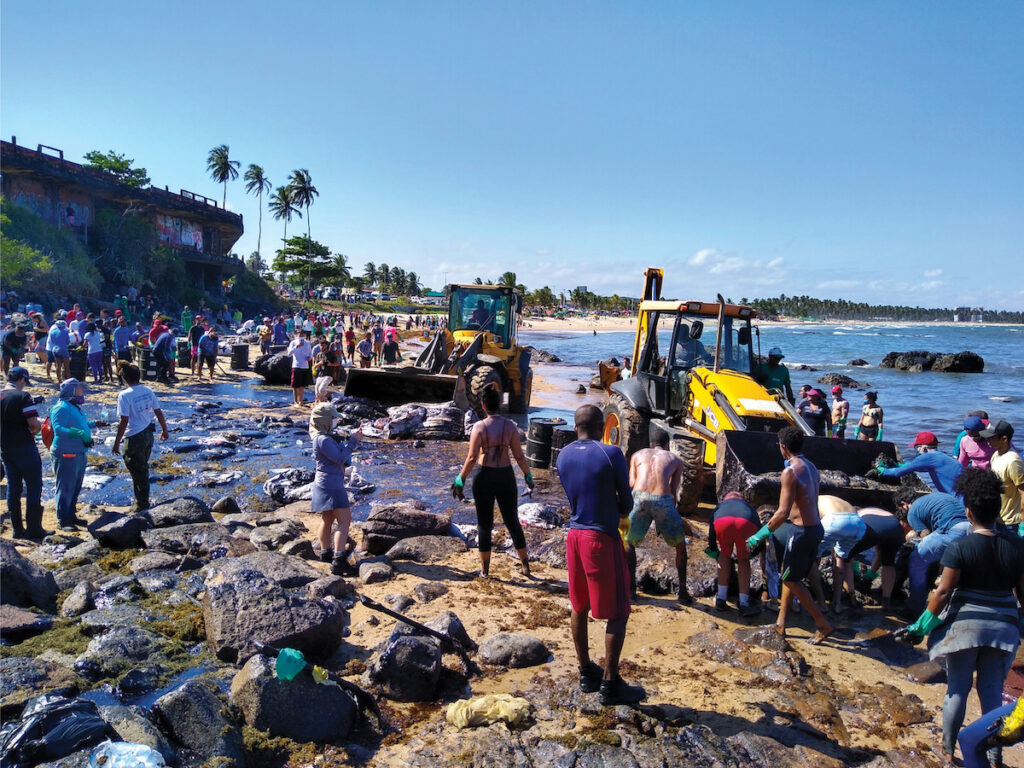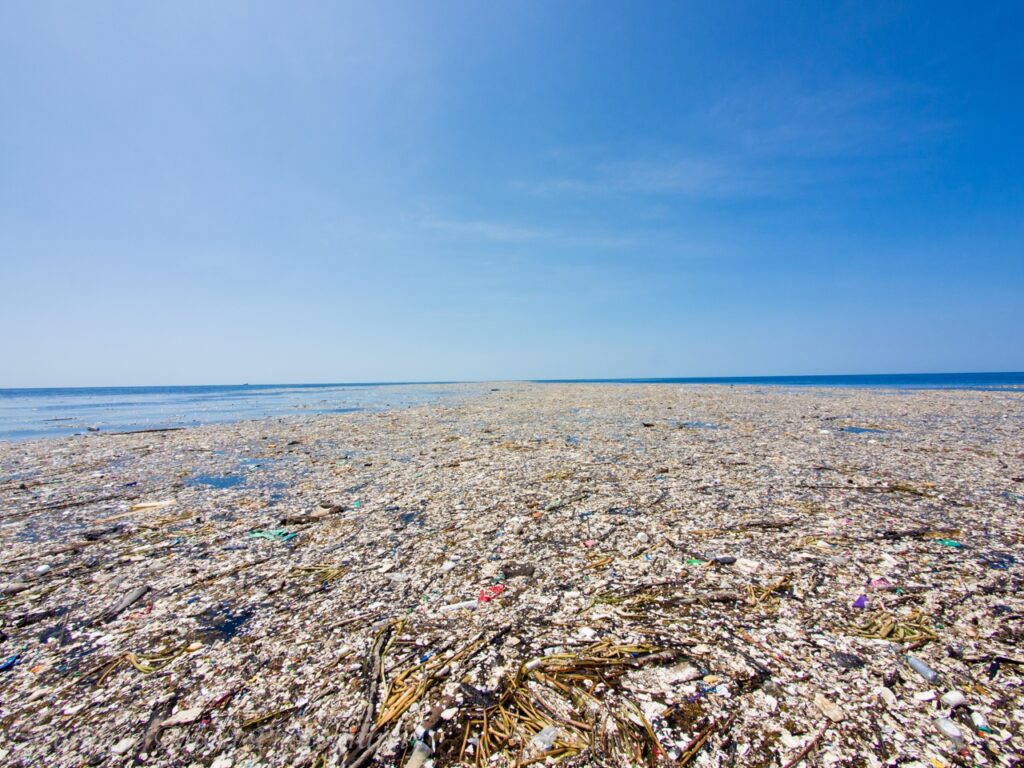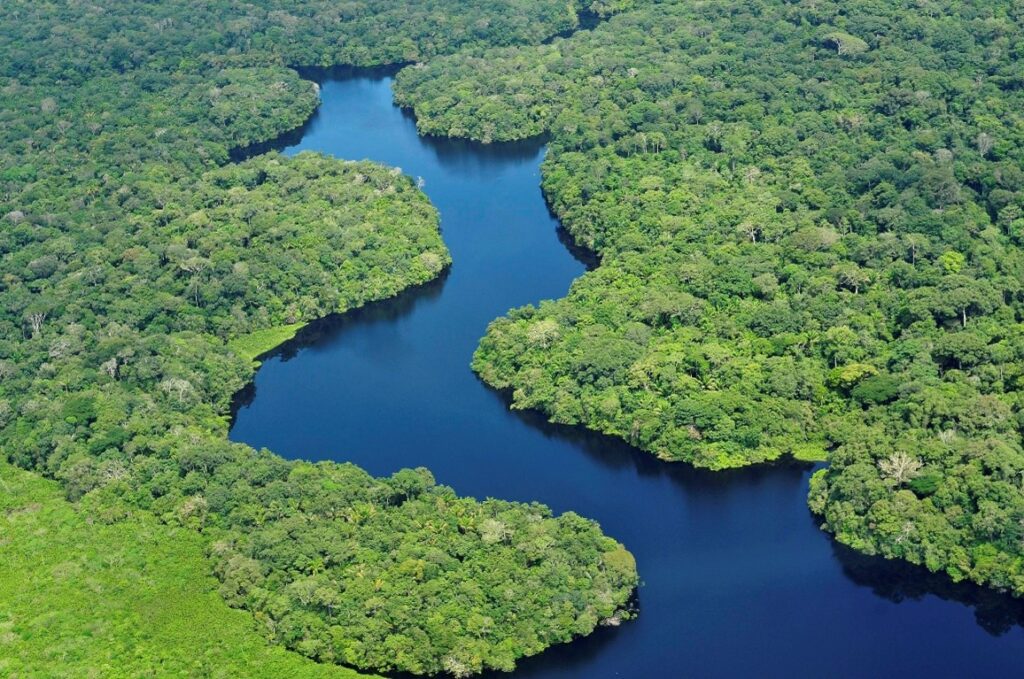
Brazil struggled to identify the tanker responsible for the 2019 oil leak that contaminated half of the country’s coast, causing large environmental and economic losses. Thousands of volunteers cleaned the oil-stained beaches. . Source: Environment Justice Atlas
By Mariana Meneses and James Myers
In August 2019, a massive oil spill struck Brazil’s northeastern coast, becoming the region’s worst environmental disaster.
As reported by Maria Elisabeth de Araújo et al (2020), it began in the state of Paraíba and eventually affected over 70% of the coastline in other northeastern states, reaching nearly 500 locations by November.
Research suggested the disaster was result of offshore oil transportation near fragile reef ecosystems by a Greek-flagged ship destined for Singapore after loading oil at Venezuela’s San José terminal. The route, dangerously near maritime habitats, was possibly chosen to avoid detection due to U.S. sanctions on Venezuelan oil commerce. No action was taken by any international party to clean up the mess and harm to Brazilians.
Crude oil breaks down into various components when in contact with seawater. These processes pose significant threats to marine and human health due to the release of harmful compounds and heavy metals. Despite health risks and a lack of knowledge in the early crisis days, volunteers from diverse backgrounds took spontaneous, collective action. To assist them, centers in universities and affected areas provided crucial personal protective equipment, water, and food for beach cleanup.
Four years later, near the end of 2023, traces of oil are still found in the seashore sand.
This is only one example of significant injury to the environment caused by human activity.
Technologies to remediate existing damage, and damages that continue to occur daily, are needed as much as clean technologies are required to prevent environmental harm in the first place. Investment in cleaning technologies will protect the uncountably vast number of organisms – of which we humans are only one type – that depend on Earth’s environment for life.
Many human actions have long-lasting environmental repercussions, since nature operates in a complex and extensive web of interactions over long periods of time. Whether it’s deforestation, pollution, or habitat destruction, the effects of our actions can echo through ecosystems, affecting not only the immediate area but also harming, and often killing, many species of living organisms and the ecological processes that sustain them. Globalization exacerbates the effects in distant communities that may only suffer the cost without collecting any benefits.
Recognizing this interconnectedness highlights the importance of responsible and sustainable practices, both to mitigate long-term harm and preserve the delicate balance of our natural world. We’ll take a look at some of the evolving technologies and legislative actions that give hope for our ability to address the problems of our own making.

Volunteers try to clean some of the oil off the beaches in Brazil’s Northeast, in 2019. Source: Maria Elisabeth de Araújo et al (2020)
#1. Legal Liability and Financial Penalties for Offenders Are Being Strengthened and Enforced.
The European Parliament has established a directive on environmental liability to prevent and remedy environmental damage.
This directive, known as the Environmental Liability Directive (ELD), holds operators whose activities have caused environmental harm financially liable for remedying their damage. The ELD covers damage to protected species and natural habitats, water, and land. The aim is to encourage measures and behaviour that will avoid environmental injury in the first place or, if it occurs, to ensure it is fully remedied.
In the United States, environmental liability is regulated by several federal laws and regulations, including the Clean Air Act, the Clean Water Act, and the Comprehensive Environmental Response, Compensation, and Liability Act, which governs contaminated site cleanup. The Environmental Protection Agency (EPA) is responsible for holding entities legally accountable for environmental violations.
The effectiveness of these regulations can vary depending on many factors, including the specific laws in each affected country, the enforcement of these laws, and the practices of individual companies.
Globally, a recent development has been the Agreement under the United Nations Convention on the Law of the Sea on the Conservation and Sustainable Use of Marine Biological Diversity of Areas beyond National Jurisdiction, which was adopted in June 2023. The goal of the new agreement is “to ensure the conservation and sustainable use of marine biological diversity of areas beyond national jurisdiction, for the present and in the long term,” based on a list of principles including “the polluter-pay principle.” It allows for the creation of processes for managing specific areas, like marine protected areas, in order to protect and responsibly oversee important habitats and species in the open ocean and the international seabed region. The agreement also takes into account the unique challenges faced by small island nations and countries without direct access to the sea.
However, although this agreement is an example of the UN’s ongoing efforts to establish international legal frameworks for environmental conservation, the enforcement of environmental laws, including the imposition of financial penalties, largely falls under the jurisdiction of individual countries. For example, the United States, a significant contributor to global pollution, has not ratified the 1997 Kyoto Protocol for greenhouse gas reduction and several other crucial environmental treaties. The issue is complex because reliance cannot be placed solely on the goodwill of influential nations, nor can their sovereignty be infringed. This underscores the importance of public awareness in addressing environmental challenges.
Legislation requires consultation, drafting, debate, and enactment – all of which consume a significant amount of time. Capital, however, is not patient, and economic forces drive rapid technological change for profitable activities. For example, although global internet use began rapidly expanding nearly 25 years ago, legislators are still struggling to address some its earliest issues like cyber-criminals and malicious actors. As the threats of data and privacy theft mount by the day, the Council of Canadian Academies highlights that addressing harms like these “requires both legal and non-legal approaches that can keep pace with technological change and protect privacy and human rights.”
We are now at the point that practically all of our essential functions in daily life depend, in some way or another, on technology. Is legislation, some of it enacted before the internet was invented, sufficiently detailed to defend our way of life?
Many legislative provisions for the environment were put in place decades ago, before the explosion of new technological devices and practices that have spawned many different types of environmental harm. Even when a country introduces laws to address emerging environmental problems, it often lacks mechanisms to enforce its provisions over activities in another nation. The unregulated industrial discharge of toxic chemicals from one nation reaches the shores of every coastline nation. A country’s failure to enact controls over the release of smog from the smokestacks of its factories poisons the air that travels from continent to continent. Affected people living in other countries have no means of stopping the pollution at its source, and polluters are often able to evade indirect measures such as economic sanctions.
We all breathe the same air.
#2. Developing Cleaner Technologies, and Technologies that Clean, When Legislative Measures Aren’t Enough
The rapidly increasing popularity of electric vehicles highlights the limits of national regulations in addressing the global scope of environmental harm caused by EV battery production. At the same time that countries are introducing regulations restricting future production of fossil fuel-burning vehicles and providing incentives for EV adoption, there remain no global mechanisms to control the environmental consequences of EV production.
While driving an EV doesn’t produce the toxic emissions of internal combustion engines, EV production causes significant injury to the environment. Lithium is a crucial element in EV battery electricity cells, and Earth.org reports that the mining and processing of lithium for only 100 batteries requires a staggering 2 million metric tons of water. Chile, a major lithium producer, consumes 65% of the region’s water in the extraction of lithium.
In cases like this, where the environmental consequences extend across many national borders, development of technologies that either avoid harmful activities, or clean up the mess left behind, provide hope.
For example, when EV batteries reach the end of their lives, they don’t have to wind up in landfills.
Instead, specialized processors exist to separate the batteries into their components, including wires, circuitry, plastics, and electricity-producing cells. The cells and circuits undergo a crushing process to recover valuable metals like nickel and lithium. Although the plastics aren’t typically recyclable, they constitute a lesser portion of the battery’s environmental toll. The real treasure lies within the cells, which house precious materials such as lithium, cobalt, manganese, nickel, and, to a lesser extent, aluminum.
Some vehicle manufacturers like Nissan are repurposing batteries from old vehicles in alternative applications, while Volkswagen is venturing into battery recycling, with plans to recover up to 95% of the raw materials from a battery pack, including lithium, nickel, cobalt, and manganese.
Where Do EV Batteries Go When They Die?
Promising Solutions for Plastic Pollution and Recycling
A major environmental problem is plastic pollution. Plastic disrupts natural processes, and the recent discovery of plastic in human breast milk is an alarming indicator of the consequences of plastic use and production that are harming not only the children of today but will harm generations of children in the future. So, what have we been doing to clean up our plastic mess?
Recycling is one way to reduce plastic waste, preventing materials that would otherwise pile up in landfills from damaging the environment.
Nonetheless, there are many complexities in recycling practices. Not all plastics can be recycled, and some plastic varieties require specialized recycling methods that are not generally available. For instance, polyethylene terephthalate (PET) plastic used for water bottles is easier to recycle than PVC plastic utilized in pipes. Furthermore, recycled plastic may be of lower quality, and certain regions may lack the infrastructure or regulatory framework to collect and recycle specific plastics. As well, plastic can undergo only a limited number of recycling cycles before it deteriorates to the point where it is no longer useful, while the recycling process itself may cause environmental damage from energy consumption and discharge of pollutants.
Emerging technologies aim to improve recycling efficiency and reduce its environmental toll.
For example, chemical recycling can break down plastics into their molecular components, which can then be used to create new materials without the quality degradation associated with mechanical recycling.
Researchers at the University of Colorado Boulder have developed a novel method to recycle PET in bottles and packaging. The team used a combination of electricity and chemical reactions to break the plastic into its molecular components. By combining PET with a specific molecule and applying a small electric voltage, the plastic disintegrated within minutes. The researchers envision a future where molecular materials from used plastic bottles can be used to create new containers, minimizing waste. Although the process is still in its early stages, and further optimization and scaling are needed before the method can be implemented on an industrial scale, the team’s electrochemical approach holds promise for addressing the global plastic problem.
A Future With Biodegradable and Compostable Plastics?
To reduce plastic pollution, there is a growing interest in plastic alternatives made from biodegradable or renewable materials.
These alternatives break down more quickly and leave behind less harmful waste. Some examples of plastic alternatives include bioplastics made from corn starch or cellulose-based materials like wood pulp. The food packaging industry presents a practical use case for plastic alternatives, aiming to reduce waste and prevent harmful chemical contamination. Biodegradable materials, such as mushroom-based packaging and edible films made from seaweed, are being embraced by some companies. Although these are an improvement over traditional plastic, they are not a perfect solution. In many cases, these materials still require specialized treatment to break down properly, for example requiring industrial composting facilities or high temperatures.
Furthermore, the production of bioplastics can still have negative long-term consequences, such as changing land use and increased use of fertilizers and pesticides.

Making biodegradable plastic compostable: in its usable form (left) and after composting in 3 days (right). Credit: Berkley News
Capturing Carbon to Mitigate Environmental Damage from Greenhouse Gases
Recent innovations in carbon capture techniques, such as those developed by scientists at MIT, offer promising solutions for addressing carbon dioxide (CO2) emissions from industrial sources.
Like methane, carbon dioxide is a gas that traps heat in the atmosphere, disrupting the natural temperature balance of the climate and heating the earth in a greenhouse-like effect. The team’s approach integrates the capture and conversion of CO2 within a single energy-efficient system, potentially powered by renewable energy sources. This method employs electrodes to attract CO2 released from a material that absorbs the gas, and subsequently converts it into a reusable form.
The effectiveness of this process is dependent on the purity of the CO2 that comes into contact with the electrode, making it particularly suitable for industries with concentrated emissions, such as steel, cement, and chemical manufacturing. These industries face unique challenges in decarbonization due to their reliance on fossil fuels in production processes. While this system may not be well-suited for capturing and converting emissions directly from the atmosphere, it holds significant promise for addressing emissions from industries that are inherently difficult to decarbonize fully.
Scientists Have Devised a New Way to Identify the Location of Plastic Waste in the Oceans
Microplastics are everywhere, especially in the oceans, and now scientists are using satellites to locate their sources and locations from space.
The US National Oceanic and Atmospheric Administration (NOAA) defines microplastics as fragments of any plastic that are less than 5 mm in length (the size of a sesame seed), and researchers noticed that these small bits of plastic seem to travel with certain substances that float on the water and make the surface appear smooth. These substances are called surfactants and they can be seen by a group of satellites that NASA uses to monitor hurricanes.
By watching these surfactants, scientists can figure out where the microplastics are going.

A small fraction of the Great Pacific Garbage Patch, an area of an estimated 1.6 million square kilometres in the Pacific Ocean with islands of floating debris and widely dispersed microplastics that often defy satellite imaging. Image: 10rivers1ocean.com
In their research, the scientists used a large indoor tank to mimic ocean currents.
They found that microplastics alone don’t make the water look smooth, which occurred only when they added the surfactants. These surfactants often appear with microplastics since they are a by-product from the manufacture and breaking down of plastic.
The study provides valuable insights into the dynamics of ocean pollution, and sheds light on the pervasive issue of microplastic contamination in our oceans.
Expanding the Circular Economy
Another area of technological development is the creation of closed-loop systems, where products are designed to be recycled into new products without degradation.
This approach, sometimes called “cradle-to-cradle” design, can reduce waste and promote a circular economy. While these technologies are promising, they are still in their early stages and face many challenges in scaling up and commercialization. However, continued innovation and investment have the potential to expand their efficiency and use.
Rachel Sheila Kan, founder of The Ecosystem Incubator, has 23 years of experience as a designer and design manager in the fashion industry, where she has witnessed ethical concerns and environmental challenges.
The Ecosystem Incubator is a collaboration of individuals and small businesses engaging in sustainable fashion production. Rachel is particularly concerned about the detrimental effects of synthetic fibers like polyester, which release microplastics into the oceans. Her mission is to drive a shift towards a more sustainable and collaborative approach in the fashion industry, advocating for a regenerative system that prioritizes both people and the planet over economic growth.
Improving Waste Management
One important method for reducing plastic pollution is improving waste management infrastructure in developing countries.
For instance, a 2022 research project looked at Waste to Energy (WtE) generation in developing nations, specifically in Sub-Saharan Africa and South Asia. This technology uses a number of methods to transform waste materials into useful heat, electricity, or fuel. This method of recovering energy helps decrease the amount of waste going into landfills and generates sustainable energy.
By investing in waste collection and recycling systems, as well as implementing policies and regulations, countries can prevent plastic from entering the environment in the first place and reduce their contribution to the global problem.
Increasing Public Awareness of the Problems and the Solutions
Addressing plastic pollution also requires a shift in consumer behavior and attitudes towards plastic.
This can include education campaigns to raise awareness about the issue, as well as programs to encourage behavioral change, such as the use of reusable bags and bottles. Creating a cultural shift towards sustainable practices can lead to lasting change and support a more sustainable future for the planet.

Protecting the sustainability of Amazon rainforest is a global priority. Image: Neil Palmer
In the quest for efficient environmental cleaning technology, it is essential to recognize that nature’s ecosystems ultimately offer the most effective solutions.
While we must continue our search for innovative cleaning techniques, we must also remain steadfast in preventing harm to these natural systems and holding ourselves accountable, emphasizing the vital importance of prevention and accountability both to present and future generations.
Interested in exploring related topics? Discover these recommended TQR articles.
- Life Is Defined by Biology, Not Physics
- Mega-trees: The Critical Role and Vulnerabilities of Nature’s Giants in Forest Ecosystems and Climate Change Mitigation
- New Light on Nature’s Technology Connects Plant-Microbe Interactions and Climate Change
- Playing Jenga with the world: the feedback of human activities on the trends of extreme weather events worldwide
- Saving the Planet: Nobel Prize Recognizes Climate Science, but Will Mindsets Change in Time to Sustain Nature’s Potential and Value?
* We use free AI software to generate text-to-image graphics to help convey abstract ideas in our articles. We give credit to the software each case, but we want to emphasize that we are not promoting any of them.



